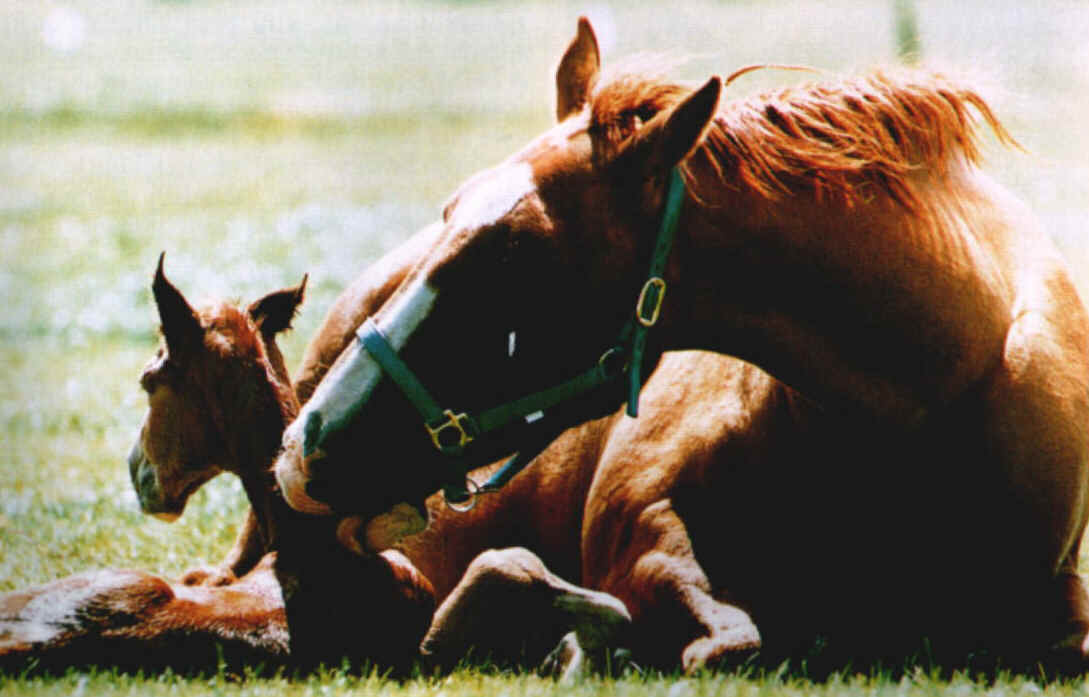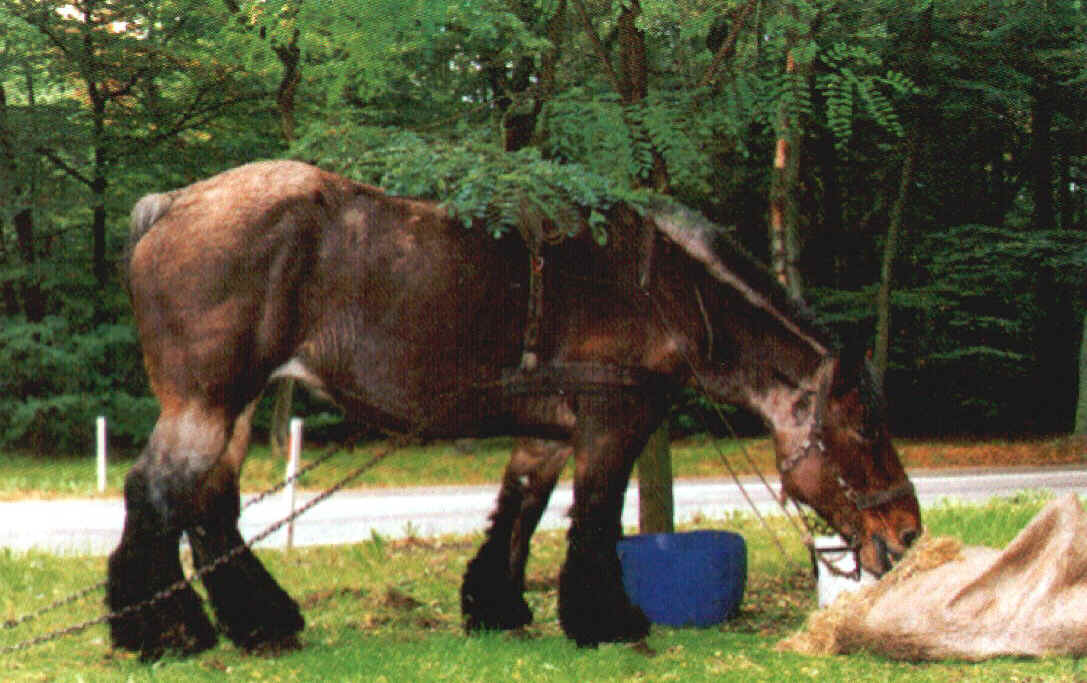



BELGIUM HEAVY DRAFT HORSE
 Breed
of working horse, also called the Brabant for the area of Belgium
where it was developed. The oldest of the heavy working-horse
breeds, the Belgian heavy draft horse descends directly from a
prehistoric European horse and the Ardennais horse. This horse
was the foundation for other breeds of heavy work horses,
including the Suffolk Punch, Clydesdale, and Shire. The prominent
trait of the Belgian heavy draft horse is its phenomenal
strength. This horse has a powerful body with a broad, muscular
chest, large shoulders, and huge, muscled hindquarters. It weighs
about 800 to 1000 kg (about 1760 to 2000 lb) and stands about 160
to 170 cm (about 63 to 67 in, or 15.5 to 17 hands) at the withers
(the sides of the ridge between the shoulder blades). The short,
dense legs are extremely strong, and the medium-sized feet are
solid. The thick, arched neck supports a square-shaped head,
which is small in proportion to the body. The coat of the Belgian
heavy draft horse is colored chestnut (gold), bay (reddish), or
roan (black, brown, or chestnut mixed with white hairs). The
Belgian heavy draft horse has a smooth, forceful step rather than
a high or fancy motion like the Clydesdale. During the Middle
Ages, the Belgian heavy draft horse was known as the Flanders
Great Horse and the Great War Horse. William the Conqueror, who
invaded England in 1066, led his army mounted on a Belgian heavy
draft horse. William and his horse each wore about 440 kg (about
200 lb) of armor. The Belgian heavy draft horse has been used
throughout history for military transport during wars in Europe,
including World War II (1939-1945). The Belgian heavy draft horse
prized for its legs of steel was for centuries used by farmers in
Flanders, now Belgium, to plow their wet, heavy soil. Even with
today's mechanized farming techniques, this horse maintains its
place on the farm. The wet soil of the European low lands can bog
down a tractor, but not a Belgian heavy draft horse. It was
introduced in the United States in the late 19th century, where
it became the preferred draft horse. It still is used in the
traditional collection of syrup from maple trees in New England.
Breed
of working horse, also called the Brabant for the area of Belgium
where it was developed. The oldest of the heavy working-horse
breeds, the Belgian heavy draft horse descends directly from a
prehistoric European horse and the Ardennais horse. This horse
was the foundation for other breeds of heavy work horses,
including the Suffolk Punch, Clydesdale, and Shire. The prominent
trait of the Belgian heavy draft horse is its phenomenal
strength. This horse has a powerful body with a broad, muscular
chest, large shoulders, and huge, muscled hindquarters. It weighs
about 800 to 1000 kg (about 1760 to 2000 lb) and stands about 160
to 170 cm (about 63 to 67 in, or 15.5 to 17 hands) at the withers
(the sides of the ridge between the shoulder blades). The short,
dense legs are extremely strong, and the medium-sized feet are
solid. The thick, arched neck supports a square-shaped head,
which is small in proportion to the body. The coat of the Belgian
heavy draft horse is colored chestnut (gold), bay (reddish), or
roan (black, brown, or chestnut mixed with white hairs). The
Belgian heavy draft horse has a smooth, forceful step rather than
a high or fancy motion like the Clydesdale. During the Middle
Ages, the Belgian heavy draft horse was known as the Flanders
Great Horse and the Great War Horse. William the Conqueror, who
invaded England in 1066, led his army mounted on a Belgian heavy
draft horse. William and his horse each wore about 440 kg (about
200 lb) of armor. The Belgian heavy draft horse has been used
throughout history for military transport during wars in Europe,
including World War II (1939-1945). The Belgian heavy draft horse
prized for its legs of steel was for centuries used by farmers in
Flanders, now Belgium, to plow their wet, heavy soil. Even with
today's mechanized farming techniques, this horse maintains its
place on the farm. The wet soil of the European low lands can bog
down a tractor, but not a Belgian heavy draft horse. It was
introduced in the United States in the late 19th century, where
it became the preferred draft horse. It still is used in the
traditional collection of syrup from maple trees in New England.
Akhal Teké - Andalusian - Appaloosa - Arabian - Ass - Australian Stock Horse - Bashkir Belgium Heavy Draft horse - Cleveland Bay - Clydesdale - Dutch Warmblood - Gelderlander - Hackney - Holsteiner - Paard (algemeen) - Irish Draught - Lippizaner - Missouri Fox Trotter - Morgan Horse - Mule - Mustang - Oldenburger - Palomino - Percheron - Peruvian Paso - Pinto - Quarter Horse - Selle Francais - Standardbred - Tarpan - Tennessee Walker - Trakehner - Ungulate (onevenhoevigen) - Zebra -